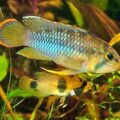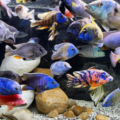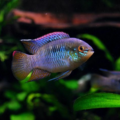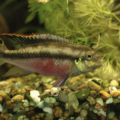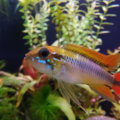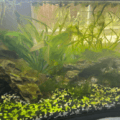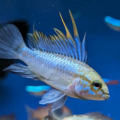Discover the intriguing traits of Telmatochromis temporalis, a cichlid native to Lake Tanganyika. This comprehensive guide includes care, breeding, and habitat tips.

If you’re an aquarist who prioritizes fascination over beauty, you would love this shell-dwelling fish overview.
Today we are exploring the world of the East African Lake Tanganyika cichlid, Telmatochromis temporalis. This species is notorious as a shell-dweller adaptable to any living condition.
Although they lack colorful scales or other physical features that would make them strikingly beautiful, their behavior makes up for it.
This Telmatochromis temporalis care guide contains professional tips on overall care, habitat, and breeding of these species, which is ideal for beginners and experts. So, pay close attention to each point.
Are you ready?
The Unique Appearance of Telmatochromis Temporalis
When you combine the rocky Lake Tanganyika environments and genetics, you’ll get the hardy and fascinating Telmatochromis temporalis appearance. We’ve already established that this fish isn’t conventionally beautiful, but it’s worth checking out.
There are two ways of identifying Tanganyika cichlids – size, color pattern, and unique traits.

Size
An adult Telmatochromis temporalis fish has a chunky body that grows about 2-4 inches (5-10cm) long. But the real intrigue lies in their color patterns and unique traits.
Color Pattern
Its coloration is typically neutral and ranges from tan-brown to gray, with subtle strips and mosaic patterns that resemble rocky substrates.
Unique Traits
This fish has a little hump on its head with short fins and dark eyes. Its physical features and natural habitat make the Lake Tanganyika cichlid develop shell-dwelling fish traits. They love living in snail shells and caves and use their elongated fins to navigate rocky waters.
Designing the Perfect Habitat for Telmatochromis temporalis

You’re about to learn how to recreate the natural habitat for Tanganyika cichlids. I’ve split this bit into two parts, starting with their tank and ending with the decor.
Tank Size and Layout
Looking at a picture of this species, you’ll think it’s large, but in reality, it’s average in size. So, your ideal Telmaochromis temporalis tank setup should have the following specifications:
| Tank Size | 20 gallons/pair | 40 gallons/small community of 5 fish |
| Shape | Rectangular |
| pH level | 7.5 – 9 (Highly Alkaline) |
| Hardness | 10 – 20 dGH (Very Hard) |
| Temperature | 75 – 82℉ |
Substrate and Decor
For your shell-dweller aquarium decor, add snail shells or fine sand mixed with gravel or pebbles to mimic its rocky habitat. Also form caves with driftwood, rocks, and natural plants like Vallisneria and Anubias for aesthetic appeal.
See Also: 15 Dwarf Cichlids for a Peaceful Community Aquarium
Dietary Requirements of Telmatochromis temporalis
The shell-dwelling cichlid diet consists of plants and live foods because they’re omnivores.
Diet Suggestions
Creating a balanced diet is good for Tanganyika fish nutrition, so use this table as a diet guide:
| Staples | High-quality Pellets, Flakes |
| Supplements | Live Food – Brine Shrimp, Bloodworms |
| Vegetables | Blanched Spinach, Spirulina |
These foods help maintain a vibrant coloration and overall health.
Feeding Tips
Form a strict regimen for feeding Tematochromis temporalis to prevent health hazards. Give them portions they can consume within 2-3 minutes twice daily.
How to Breed Telmatochromis temporalis Successfully

First, set up an ideal breeding tank for spawning Tanganyika cichlids, and then dedicate yourself to raising the shell dweller fry.
Breeding Setup
The shell you added to the substrate during tank setup is good for spawning when breeding Telmatochromis temporalis. Adjust the water temperature to 77 – 80℉ and the hardiness to 12 – 15 dGH while ensuring pristine conditions.
I recommend having a separate breeding tank or using a divider to create a living and breeding area.
Choose only two breeders per tank and feed them high protein with vegetables. Then, wait for spawning behavior.
Females lay 10-30 eggs in the shell while the males will fertilize them externally. The parents then guard and fan their eggs for oxygen before they hatch in 4-6 days.
Fry Care Tips
After hatching, remove the breeders and focus on the fry.
The young fish will feed on yolk sacs, infusoria, and liquid fry diets before they become free-swimming within a week of hatching. At this point, feed them baby brine shrimp and finely crushed flakes for muscle growth.
As they grow, separate the fast-growing fry from smaller ones to prevent aggression, territoriality and predation.
Compatible Tank Mates for Telmatochromis temporalis
Ideal tank mates for Telmatochromis temporalis should have the same environmental needs, similar size, and temperaments for a harmonious existence.
Typically, Telmatochromis temporalis is a peaceful Tanganyika fish, but putting it in stressful situations can make it aggressive. So, I drew this table to show you incompatible and compatible fish for shell dwellers.
| Compatible Species | Avoided Species |
| Other Tanganyika cichlids – Julidochromis Synodontis catfish Nerite Snail | Aggressive, hyperactive and larger fish Small Shrimps |
See Also: 12 Best Freshwater FISH IDEAS for a 10-Gallon Tank
Preventing Common Health Issues in Telmatochromis temporalis
These Telmatochromis temporalis health tips guarantee your pets a healthy, happy, and long life!
Preventative Measures
Common health concerns of this species include parasitic infections, stress, and poor water quality. So, preventing cichlid diseases starts with proper care of your pet’s living environment and continues with monitoring its health conditions. You can do this by:
- Performing regular water changes at least 20-30% weekly
- Adding a high-quality filtration system to clean the water
- Preventing overcrowding in the aquarium. Remember, it’s 20 gallons/pair.
Signs of Illness
| Symptoms | Illness | Causes | Treatment |
| Appetite loss, Laziness | Bloating | Overfeeding | Fasting for 1 – 2 days |
| Erratic Swimming, Scratching, | Flukes | Parasites | Improve water quality Quarantine new fish |
| White Spots | Ich | Stress and Temperature fluctuation | Stabilize water conditions Quarantine new fish |
| Red Sores, Ragged Fins, Fuzzy growth | Fungal and Bacterial Infections | Contaminated water and untreated injuries | Improve Water Quality Use Antifungal and Antibacterial medication |
Follow the preventive tips to enjoy having healthy shell-swelling fish in your aquarium.
Extending the Lifespan of Telmatochromis temporalis
Telmatochromis temporalis may not be pretty, but they sure do live long, lasting for up to 8-10 years.
However, that’s not set in stone. You must work hard to ensure your pets live up to their full potential.
Lifespan Factors
The usual suspects like diet, water quality, and tank mates play the biggest roles in determining whether your shell-dwellings will live long; b,t dont stress, this Telmatochromis temporalis lifespan guide has all the answers.
Care Tips for Longevity
I have two shell-dweller care tips for you –
- Regular Tank Maintenance: Periodic water changes, cleaning the tank for leftover food, and undecomposed waste go a long way in ensuring good health for your pets.
- Observation: Always address every behavioral change as it is the earliest sign of illness.
Every tip in this guide focuses on long-term care for Tanganyika cichlids, so if you’ve followed it carefully so far, your pets will be alright.
Conclusion
Oh my! You’ve reached the end of today’s Telmatochromis temporalis care guide. Wasn’t that fast? Did you read every line or skip to the end? Here’s a quick recap in case you’re like me and skimmed fast. Winks
- Telmatochromis temporalis have neutral colored scales resembling rocks
- They live in hard, alkaline water
- They’re omnivores
- They’re a peaceful species with the right tank mates
- They’re prone to regular cichlid diseases
So, did you get all the freshwater Tanganyika fish tips? If you didn’t, scroll back up because you don’t want to miss anything important.



